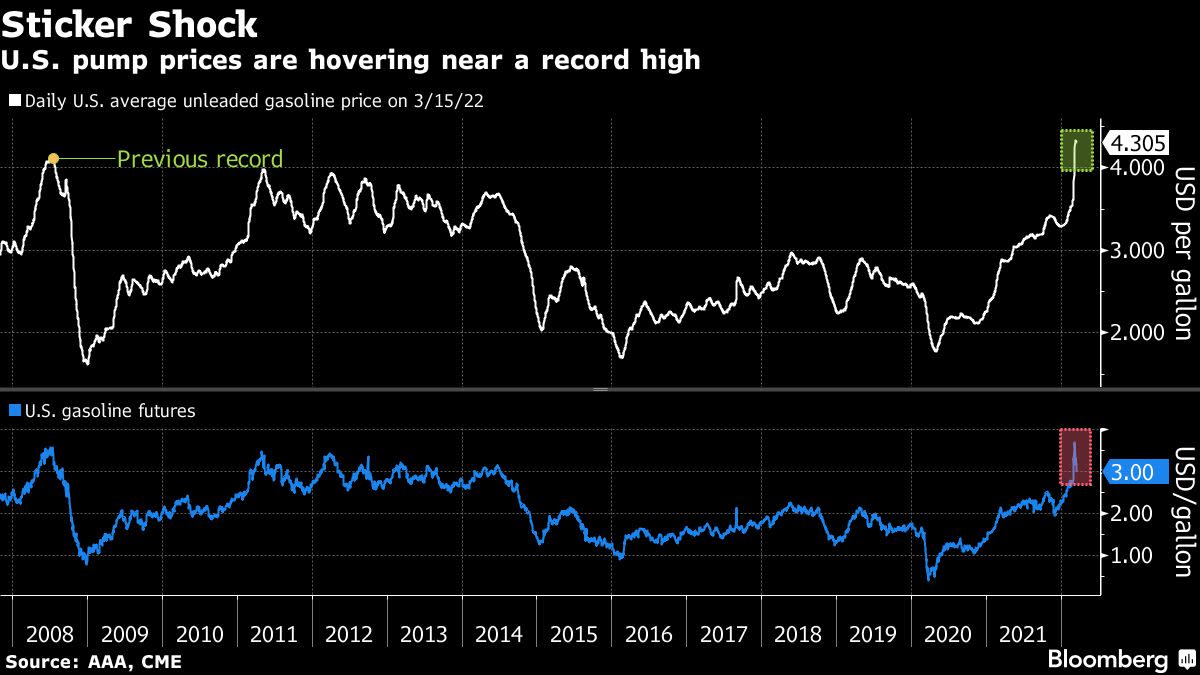
(Bloomberg) — Oil prices may have eased, but gasoline at the pump hasn’t — a familiar problem for the Biden administration grappling with elevated inflation in the U.S.
West Texas Intermediate crude futures, the U.S. benchmark, have dropped from multi-year highs above $120 a barrel touched after Russia’s invasion of Ukraine, but the national average for retail prices is still above $4 a gallon. The near record-high price levels pose a significant issue for President Joe Biden as he looks to provide relief for American households struggling with soaring energy costs. A second planned release from the Strategic Petroleum Reserve this month has had a muted effect.
“Last time oil was $96 a barrel, gas was $3.62 a gallon. Now it’s $4.31,” Biden said in a tweet on Tuesday. “Oil and gas companies shouldn’t pad their profits at the expense of hardworking Americans,” he added.
Yet, there is always a lag between movements in crude oil and pump prices as it takes time for costs to filter through the supply chain — from wholesale prices down to so-called racks that are the source of supplies for gas stations.
The time it takes to acquire crude, refine it and ship fuel to distribution facilities and service stations helps contribute to the lag, said Garrett Golding, a business economist at the Federal Reserve Bank of Dallas. “It’s not price gouging or a grand plot by the industry,” he said on Twitter. “This is how the business functions.”
Prices at the pump also more closely track movements in the gasoline futures market. Over the last week, gasoline futures traded in New York have tumbled by about 70 cents, clawing back nearly 77% of the recent surge, said Omair Sharif, president of Inflation Insights LLC.
“Unfortunately, pump prices typically adjust much faster on the way up than on the way down, so it’ll take a few weeks for the latest move to filter into what you see at the station,” Sharif said. “Still, if things hold as they are now, the national average should be back below $4 per gallon in the next month (by around mid-April) and closer to $3.80-$3.85 per gallon by late April.”
That hasn’t quelled mounting political pressure from Democrats blaming oil companies for high prices. Senate Majority Leader Chuck Schumer bemoaned “the bewildering incongruity between falling oil prices and rising gas prices,” saying it “smacks of price gouging,” and that oil executives will be held accountable. “The Senate is going to get answers, and that’s why we will be calling on the CEOs of major oil companies to come testify before Congress,” Schumer said.
Representative Alexandria Ocasio-Cortez, a Democrat from New York, also seized on Tuesday’s crude price plummet to blame sustained high gasoline prices on “profiteering” and warn “there should be consequences for it.”
The oil industry’s top lobbying group, the American Petroleum Institute, has highlighted that some 95% of retail filling stations are independently owned and not operated by oil companies.
“Across the economy, retail prices in many industries go down slower than they go up — this isn’t a new phenomenon,” said Frank Macchiarola, API’s senior vice president of policy, economics and regulatory affairs. “As we’ve seen in the past, it takes time for changing market conditions to work through the supply chain and for the price of crude oil to be widely reflected in the price we pay at local gas stations.”
In November, a group of major oil-consuming nations including the U.S. announced a coordinated plan to release crude from strategic reserves in order to bring down soaring energy costs. Prices at the pump were slow to come off then, too.
Despite elevated pump prices, there is no sign of demand destruction yet. The four-week average gasoline product supplied, a gauge of demand, is at the highest level this year, data from the U.S. Energy Information Administration showed.
©2022 Bloomberg L.P.